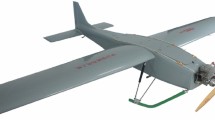Abstract
An optimization problem is formulated to maximize the coverage of the detection area for a fixed wing unmanned aerial vehicle (UAV), which performs a landmine detection mission. The UAV has mine detection devices including magnetic field sensors and chemical sensors. Due to the characteristics of the detection sensors, the UAV should fly at a certain altitude above the ground while following the terrain to perform accurate mine detection. Also, the UAV is required to maintain the pitch angle around the trim value when changing the altitude. Consequently, the altitude change rate of the UAV is limited during the mission. To maximize the mine detection capability within the limit, in this study, the entire flight interval is divided into the intervals on which the mines can be detected accurately and the intervals on which accurate detection is not possible. Logical variables are introduced to indicate the satisfaction of the requirements for accurate detection. Constraints on the logical variables are transformed into a set of linear inequalities containing continuous variables and binary integer variables. Finally, the optimization problem is formulated as a mixed-integer linear programming problem. The effectiveness of the proposed method is demonstrated through numerical simulation.





Similar content being viewed by others
References
Bemporad A, Morari M (1999) Control of systems integrating logic, dynamics, and constraints. Automatica 35(3):407–427. https://doi.org/10.1016/S0005-1098(98)00178-2
Colorado J, Perez M, Mondragon I, Mendez D, Parra C, Devia C, Marinez-Moritz J, Neira L (2017) An integrated aerial system for landmine detection: SDR-based ground penetrating radar onboard an autonomous drone. Adv Robot 31(15):791–808. https://doi.org/10.1080/01691864.2017.135139
Colorado J, Mondragon I, Rodriguez J, Castiblanco C (2015) Geo-mapping and visual stitching to support landmine detection using a low-cost UAV. Int J Adv Robot Syst 12(9):125. https://doi.org/10.5772/61236
Fernández MG, López YÁ, Arboleya AA, Valdés BG, Vaqueiro YR, Andrés FLH, García AP (2018) Synthetic aperture radar imaging system for landmine detection using a ground penetrating radar on board a unmanned aerial vehicle. IEEE Access 6:45100–45112. https://doi.org/10.1109/ACCESS.2018.2863572
Grant M, Boyd S (2014) CVX: Matlab software for disciplined convex programming, version 2.1. CVX Research. http://cvxr.com/cvx. Accessed 26 Aug 2021
Gurobi Optimization, LLC (2021) Gurobi Optimizer reference Manual. Gurobi Optimization. https://www.gurobi.com. Accessed 26 Aug 2021
Kang H, Lee S, Lee J, Kim Y, Suk J, Kim S (2021) Altitude tracking of UAV with pitch-hold constraint based on model predictive control for mine detection. In: 21st International Conference on Control, Automation and Systems (ICCAS), Jeju, Korea, 12–15 October 2021. https://doi.org/10.23919/ICCAS52745.2021.9649884
Kamyar R, Taheri E (2014) Aircraft optimal terrain/threat-based trajectory planning and control. J Guid Control Dyn 37(2):466–483. https://doi.org/10.2514/1.61339
Livshitz A, Idan M (2018) Low-cost laser range-measurement-based terrain-following concept and error analysis. J Guid Control Dyn 41(4):1006–1014. https://doi.org/10.2514/1.G002565
Livshitz A, Idan M (2019) Preview control approach for laser-range-finder-based terrain following. IEEE Trans Aerosp Electron Syst 56(2):1318–1331. https://doi.org/10.1109/TAES.2019.2933955
Lu P, Pierson BL (1995) Optimal aircraft terrain-following analysis and trajectory generation. J Guid Control Dyn 18(3):555–560. https://doi.org/10.2514/3.21422
Lu P, Pierson BL (1995) Aircraft terrain following based on a nonlinear continuous predictive control approach. J Guid Control Dyn 18(4):817–823. https://doi.org/10.2514/6.1995-3342
Malaek S, Abbasi A (2011) Near-optimal terrain collision avoidance trajectories using elevation maps. IEEE Trans Aerosp Electron Syst 47(4):2490–2501. https://doi.org/10.1109/AERO.2006.1656012
Malaek S, Kosari A (2007) Novel minimum time trajectory planning in terrain following flights. IEEE Trans Aerosp Electron Syst 43(1):2–12. https://doi.org/10.1109/TAES.2007.357150
Menon PKA, Kim E, Cheng VHL (1991) Optimal trajectory synthesis for terrain-following flight. J Guid Control Dyn 14(4):807–813. https://doi.org/10.2514/3.20716
Ministry of Land, Infrastructure and Transport (2021) National spatial data infrastructure portal. http://www.nsdi.go.kr. Accessed 26 Aug 2021
Samar R, Rehman A (2011) Autonomous terrain-following for unmanned air vehicles. Mechatron 21(5):844–860. https://doi.org/10.1016/j.mechatronics.2010.09.010
Williams P (2005) Aircraft trajectory planning for terrain following incorporating actuator constraints. J Aircr 42(5):1358–1361. https://doi.org/10.2514/1.17811
Williams P (2007) Three-dimensional aircraft terrain-following via real-time optimal control. J Guid Control Dyn 30(4):1201–1206. https://doi.org/10.2514/1.29145
Yoo L, Lee J, Lee Y, Jung S, Choi Y (2021) Application of a drone magnetometer system to military mine detection in the demilitarized zone. Sensor 21(9):3175. https://doi.org/10.3390/s21093175
Acknowledgements
This research has been supported by the Defense Challengeable Future Technology Program of the Agency for Defense Development, Republic of Korea.
Author information
Authors and Affiliations
Corresponding author
Additional information
Publisher's Note
Springer Nature remains neutral with regard to jurisdictional claims in published maps and institutional affiliations.
An earlier version of this paper was presented at APISAT 2021, Jeju, South Korea, in November 2021.
Rights and permissions
About this article
Cite this article
Lee, S., Kang, H., Lee, J. et al. Optimal Policy of Pitch-Hold Phase for Mine Detection of UAV Based on Mixed-Integer Linear Programming. Int. J. Aeronaut. Space Sci. 23, 746–754 (2022). https://doi.org/10.1007/s42405-022-00454-7
Received:
Revised:
Accepted:
Published:
Issue Date:
DOI: https://doi.org/10.1007/s42405-022-00454-7




